Author: Robbins
Reach First Ore Quicker
Deep underground ore bodies require a new approach: Rectangular rock boring machines create access and development drifts with flat inverts that enable immediate use of the tunnel by rubber-tired vehicles. These non-circular tunnel boring machines bore tunnels in rock up to 200 MPa UCS at twice the rate of drill & blast, and with fewer ground support requirements. Find out how to reach your ore body quicker, safer and more cost effectively in this exclusive webinar in conjunction with Mining Magazine.
In this recorded, 60-minute webinar you’ll learn about the successful use of a rectangular rock boring machine at Fresnillo silver mine in Mexico, where the equipment has advanced more than 1,700 meters at rates of up to 191 meters in one month. Listen in as Robbins President Lok Home discusses ongoing developments for underground mining, including ways to directly mine the ore body using tunnel boring machines. The presentation will conclude with a discussion on future developments in underground mining, moderated by Mining Magazine.
WATCH THE RECORDING
EXPOMIN
Event Name: EXPOMIN
Dates: October 25-29
Location: Santiago, Chile
Venue: Espacio Riesco
Booth: 3-F21, Hall #1
Join Robbins at the most important Mining exhibition in Latin America! EXPOMIN will be hosted in Santiago, Chile from October 25th to the 29th. Come learn more about the astonishing work our MDM5000 has been doing at the Fresnillo Mine–the first successful use of a rectangular rock boring machine. Our team of professionals are eager to meet and talk about a solution for your next underground mining project. Check out this map of the exposition hall and look for the Robbins R to find our stand location 3-F21. Stop by to see our latest products and projects!
Mineria 2021
Event Name: Mineria 2021 International Convention
Dates: October 19-22
Location: Acapulco, Mexico
Venue: Forum Mundo Imperial
Booth: 706-706A
Come join us in Acapulco, Guerrero at the 2021 Mineria International Convention and learn more about Robbins’ latest innovation, the MDM5000. The machine has bored more than 1,700 meters of a mine access tunnel in andesite and shale with quartz intrusions. Stop by the TOPO/Robbins booth 706-706A to see the astonishing work that has been done at Fresnillo mine in Mexico. Meet with Robbins international experts who are ready to discuss a solution for your next underground mining project.
Mine Development Machine: Successful Rectangular Rock Bore in Fresnillo, Mexico
A rectangular tunnel boring machine, known as the MDM5000, has successfully bored a hard rock tunnel with flat invert in Fresnillo, Mexico. Watch the video to find out more from Robbins personnel, mine officials, and those operating the new machine on a daily basis.
Robbins develops Rectangular Rock Mining Machine for Flat Invert
Robbins’ latest innovation is making good headway on a non-circular tunnel excavation in hard rock. The rectangular TBM, known as the MDM5000 (standing for Mine Development Machine with dimensions of 5.0 m x 4.5 m) is capable of excavating a flat tunnel invert for immediate use by rubber-tired vehicles. Employed by Mexico’s oldest silver mine, Fresnillo Plc, the MDM5000 is boring a mine access tunnel in andesite and shale with quartz intrusions that has defied earlier attempts using roadheaders. The successful operation is the result of extensive discussions between Robbins, who designed and supplied the machine, with TOPO machinery and Fresnillo Plc. View the video of the machine in action here.

Developed by Robbins for use in rock up to 200 MPa UCS, the MDM5000 excavates with a reciprocating cutterhead and swinging cutterhead motion to create a rectangular cross section tunnel.
“We decided to work with Robbins for their experience. A lot of people have tried to provide these kinds of machines but nobody has done it. Robbins used their experience and their skills to provide us with a rectangular profile machine,” said Fidel Morin, Projects Superintendent for Fresnillo Mine.
The technology is not only useful for the mining industry, but also for many applications in civil tunneling. While other machines have been developed for soft ground, the MDM5000 represents the first successful foray into rectangular hard rock tunneling. “We’re very pleased to add non-circular tunneling to our wheelhouse of solutions that continues to include TBMs, conveyors, cutters, and more. We see applications for the MDM wherever a rectangular profile is needed, such as train tunnels requiring a flat invert. In a traditional circular tunnel, the invert is filled or an invert segment is needed, but with the MDM 30% less rock is required to be removed from the profile,” said Robbins President Lok Home.
With more than 1,700 m of advance thus far at rates up to 52 m in one week and 191 m in one month, the MDM is significantly faster than drill & blast excavation. “We’re making history. Fresnillo is always looking for new technology, and we believe that the usage of the MDM5000 is going to be something extremely successful, not only for our company but also for the industry,” said Morin.
The MDM5000 has undergone major component enhancements during the course of its successful bore at Fresnillo mine. It was first transported to the -695 m level of the mine and underwent final assembly and launch in a cavern, where sections of the MDM were moved by crawlers and pieces were lifted by hoist. The machine is now boring a 270-degree spiral to end above the original tunnel. It will then be backed up to the original tunnel and continue driving straight ahead.
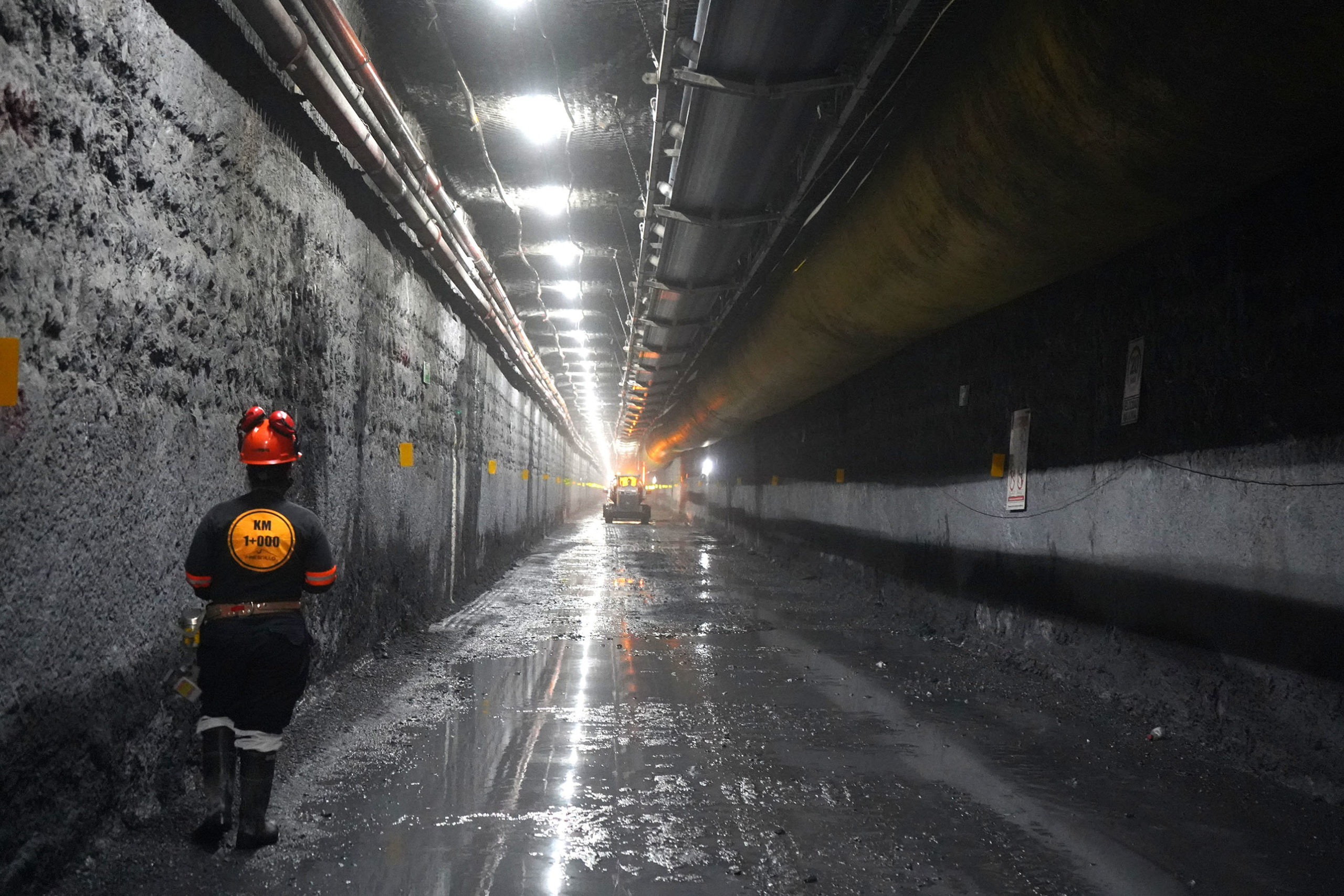
The MDM5000 is particularly useful wherever a rectangular profile is needed, such as train tunnels requiring a flat invert. The rectangular profile requires 30% less rock to be removed as compared with a circular cross section. Photo credit: Fresnillo Plc
Developed for use in rock up to 200 MPa UCS, the MDM5000 utilizes disc cutter technology proven on traditional, circular TBMs. During excavation a reciprocating cutterhead and swinging cutterhead motion create a rectangular cross section tunnel.
The MDM offers a number of advantages over drill and blast. MDM tunneling has advance rates roughly twice those of a drill and blast heading, and results in smooth tunnel walls, less overbreak, and minimized ground support. The increased advance rates are partly due to the machine’s continuous progress, unlike drill and blast operations where crews must exit the tunnel during blasting for safety. In addition, simultaneous ground support installation further increases overall advance rates compared with drill and blast operations that must install ground support sequentially.
View the machine boring at Fresnillo mine: https://youtu.be/mgFopWaf220
Turkish TBM Records, Twice Over
History has been made twice over at Turkey’s Eşme-Salihli Railway Tunnel where a 13.77 m (45.18 ft) diameter Robbins Crossover XRE TBM has set new world records for best day, week, and month in the 13 to 14 m (42.6 to 46 ft) diameter range. The machine broke all three records first in May with 25.3 m (83 ft) in one day, 117 m (383.8 ft) in one week, and 345.6 m (1,134 ft) in one month, then again in June with 28.5 m (93.5 ft), 133.2 m (437 ft), and 455.4 m (1,494 ft) respectively. The TBM, which sat in storage for seven years before being newly upgraded for this project, proves the robust durability of Robbins machines.
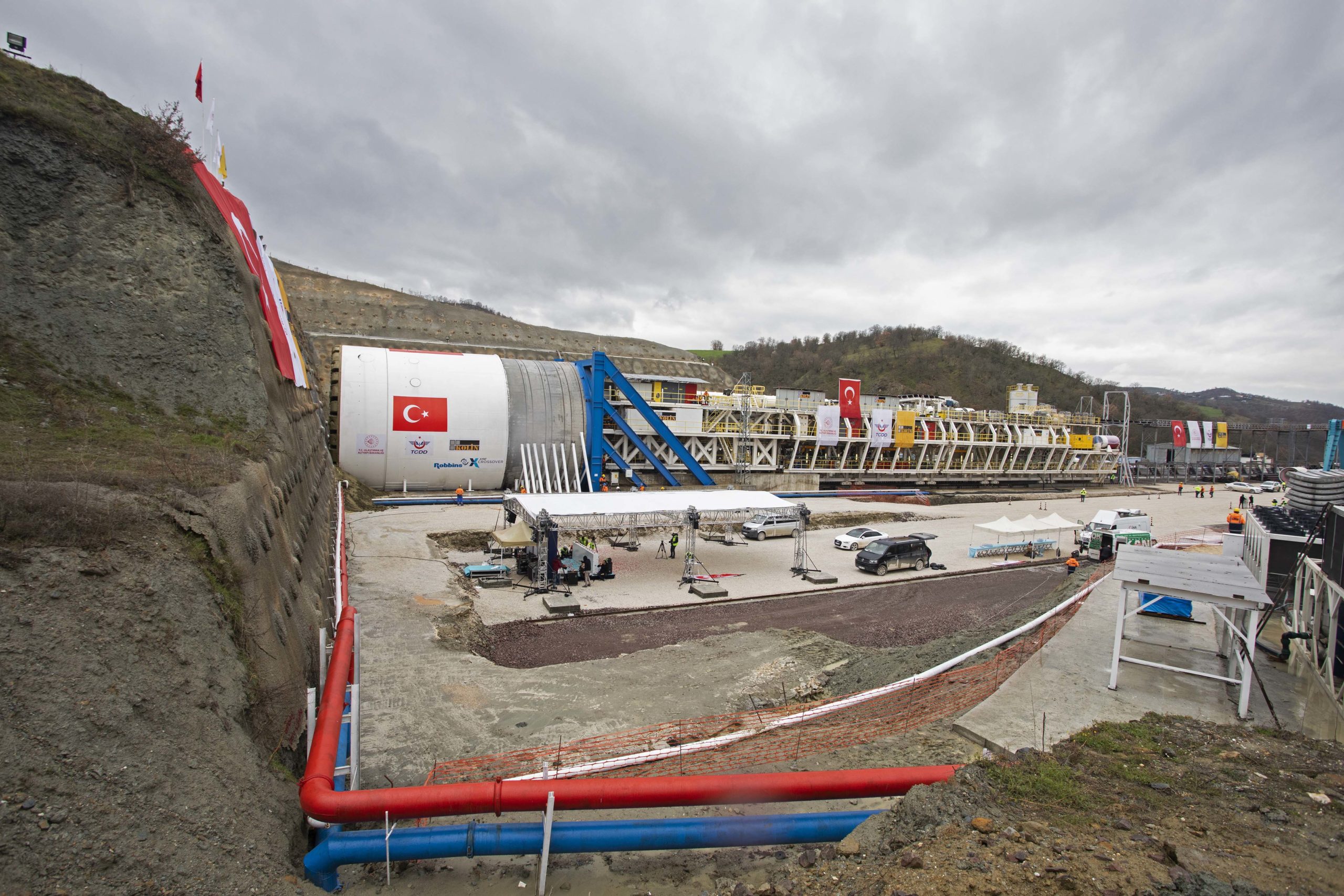
Thus far the Robbins machine has encountered a mix of mudstone and gneiss.
The Crossover TBM surpassed all previous performance rates by a machine in its size range. The closest another 13 to 14 m (42.6 to 46 ft) machine has come to these numbers was a 13.7 m (45 ft) diameter mixed ground TBM that achieved a 7 m (23 ft) average per day and a best day of 12 m (39 ft) at the Eurasia Tunnel project.
Onur Kansu, TBM Manager for project contractor Kolin Construction, attributes the machine’s success to the team operating it: “The most important reason for achieving fast advance rates is that we have an experienced and qualified team. If we open it up even further, such a team allows us to anticipate the malfunctions and to go to the solution in a very short time. In addition, all necessary maintenance is carried out on time, and the appropriate consumables are selected to increase the performance.”
The machine launched on its 3.05 km (1.90 mi) bore at the end of March 2021 as part of the Ankara-İzmir High Speed Railway Project for the Turkish State Railways (TCDD). Thus far the machine has encountered a mix of mainly mudstone with gneiss. “When we look at the overall tunnel geology,’ said Kansu, “we are excavating in complex and weak ground. In this geology, the advantages of the Robbins XRE TBM are highly favorable. The Robbins XRE TBM shows high performance in both complex and weak ground. It should also be noted that the TBM is very strong when looking at parameters such as torque and thrust.” To get through the challenging conditions, the large diameter XRE has a number of unique features. The large diameter design enables both a screw conveyor and belt conveyor to remain in place, enabling swift conversion between modes, and operation in full EPB and hard rock modes.
Regarding the future of the Turkish tunneling industry, Kansu is optimistic about the effects these new records will have: “It has been seen how well the engineers and application teams in Turkey have excelled in complex geologies and the large-scale tunneling industry. At the same time, it has shown to the whole world, especially Turkey, that with the right choices, it is possible to carry out excavations of this scale and complex geology without any problems and quickly. This project will be a pioneer in the Turkish tunneling industry, showing that faster and more economical tunnels can be built.”
Robbins XRE TBMs Cross the Finish Line in Massive Metro Project
In Spring 2021, the second of two 6.65 m (21.8 ft) diameter Robbins Crossover XRE TBMs made its third and final breakthrough for India’s Mumbai Metro Line 3. The first machine made its final breakthrough for the project in late April. The tunnel drives were a triumph for joint venture contractor Larsen & Toubro and the Shanghai Tunnel Engineering Company (L&T – STEC), as the crew and equipment overcame unpredictable terrain, high-pressure water ingress, and government-imposed lockdown orders during the Covid-19 pandemic.
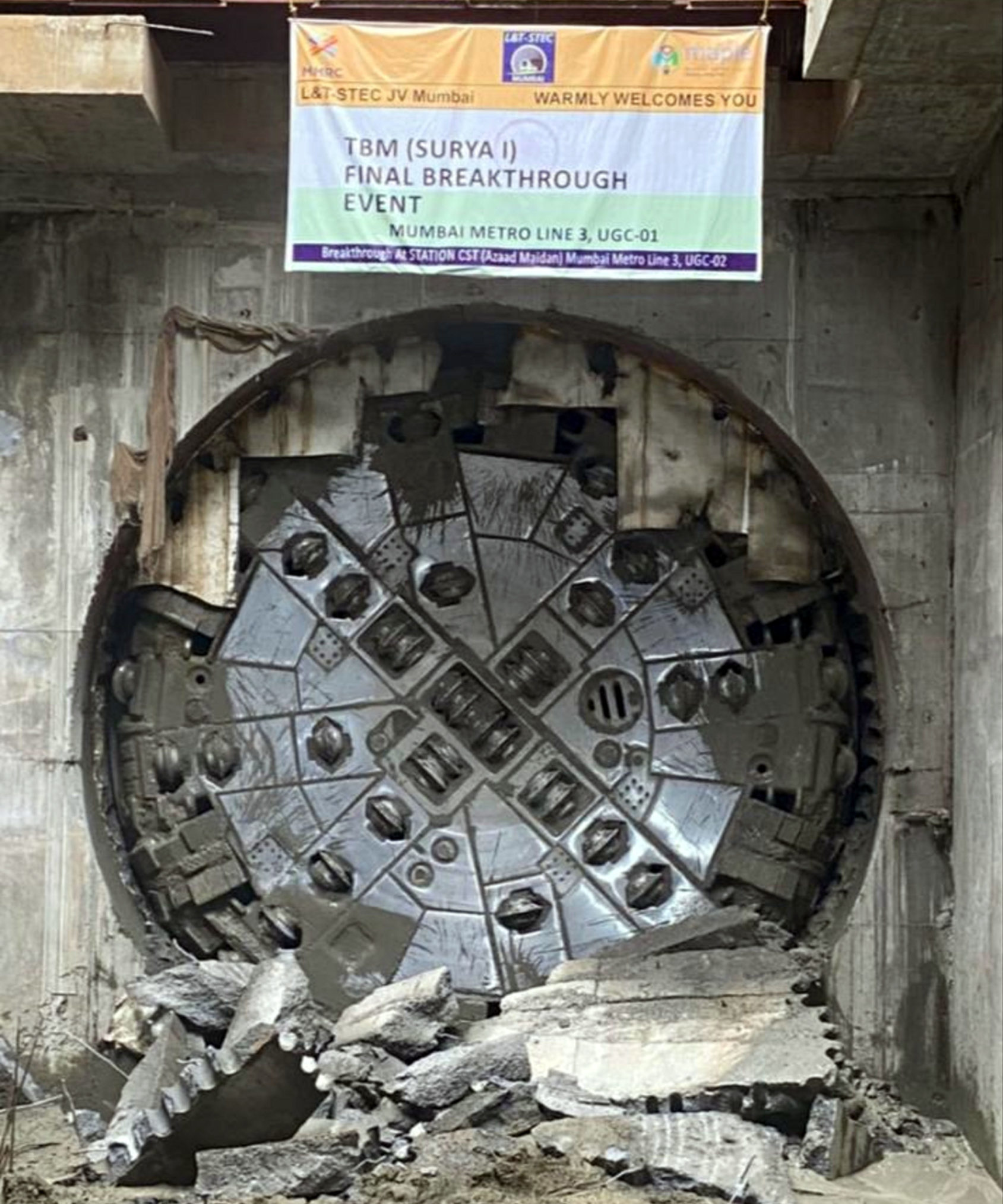
The first of the Robbins Crossover machines broke through in April 2021.
The two custom-built machines were selected to bore parallel 2.9 km (1.8 mi) tunnels between the Cuffe Parade station and CST stations, breaking through into several station sites along the way. “It is the first time in India that Dual Mode, Crossover type TBMs equipped with a horizontal screw conveyor and high torque / high speed (two-speed) cutterhead drives were used. Overall, the performance of the Crossover TBMs was found satisfactory and we are in the process of shifting these TBMs for the L&T Chennai Metro project,” said Mr. Palwinder Singh, Head – Tunnel Construction for the L&T – STEC JV.
In another first for India, the Crossover TBMs employed a unique technique in a 554 m (1,820 ft) long section from Hutatma Chowk to CST stations. They were used in the benching of the NATM Platform tunnel through basalt rock (removal of the bottom section of rock remaining in the station after conventionally removing the top section). “This requires fine control on the operational parameters of the TBM because only 25% of the cutterhead is excavating the rock mass, while the remaining 75% of the cutterhead has no contact with rock or soil. In addition, the TBM was relaunched without using a reaction frame, instead taking reaction from half segments erected during the benching of the NATM Platform Tunnel. These innovative concepts were accomplished for the first time in India at Mumbai Metro Line-3, Package 1, and I therefore have many reasons to feel proud on the completion of tunneling,” said Singh.
L&T – STEC made impressive progress throughout tunneling despite the many exacting circumstances surrounding the scope of work. Above ground, the joint venture not only had to navigate the restrictions of working within an urban environment, such as limited work hours and the slow removal of muck due to minimal space and traffic, but also faced concern for major structures such as the Mittal Towers and the historic Bhikha Behram Well located along the tunneling route. The Crossover TBMs excavated with only 15 to 20 m (49 to 65 ft) of cover separating them from these important structures, which had to be instrumented to monitor vibrations, movements, and potential settlement.
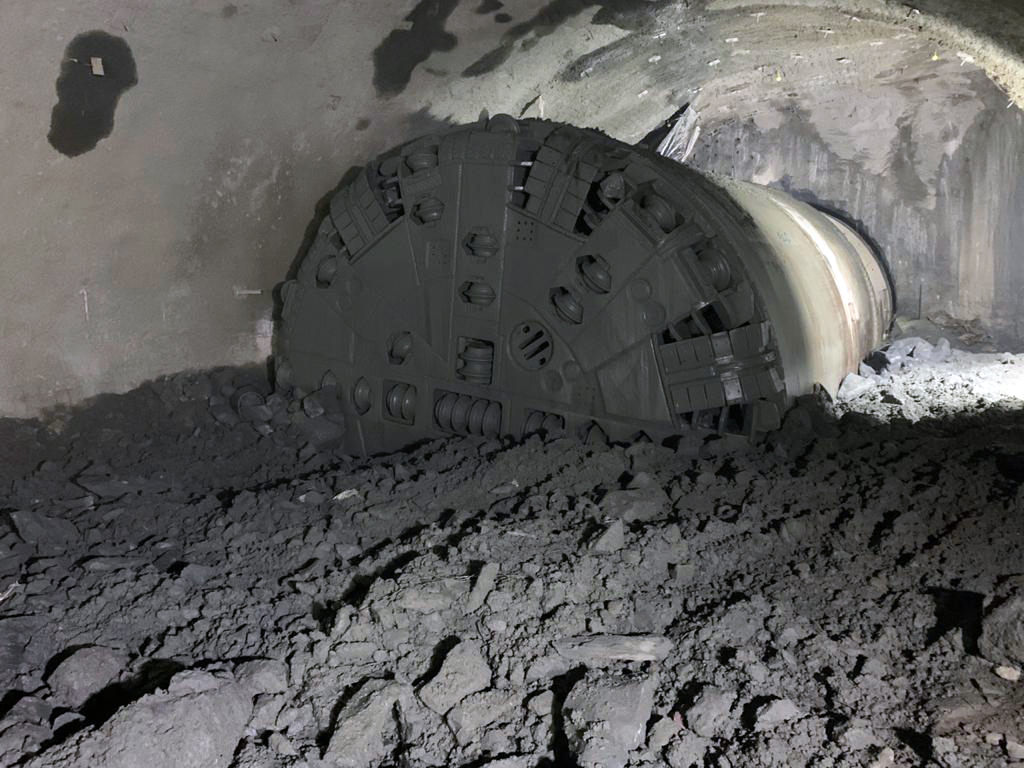
In a first for India, the Robbins Crossover TBMs were used in the benching of the NATM Platform tunnel through basalt rock in a 554 m (1,820 ft) long section from Hutatma Chowk to CST stations.
Underground, L&T – STEC faced a complex geological mix of fresh greyish basalt, soft volcanic tuffs, shale, and breccias—consolidated rocks of angular fragments of disintegrated volcanic rock. One of the biggest concerns, however, came from the tunnels’ proximity to the coastline of the Arabian Sea. During one point, TBM 1 was only 25 m (82 ft) from the coastline, with the invert level of the tunnel running approximately 22 m (72 ft) below mean sea level. As anticipated with circumstances such as these, the Crossovers faced a significant amount of groundwater with up to 300 liters/min during their excavation.
Despite these obstacles, the TBMs were still able to maintain impressive rates. TBM 2 even completed one push in a swift 14 minutes. “In fact, the boring rate of the Crossover TBMs was never an issue for us. It was only limited by the rate of muck removal and we could have finished the tunnels much faster,” said Singh.
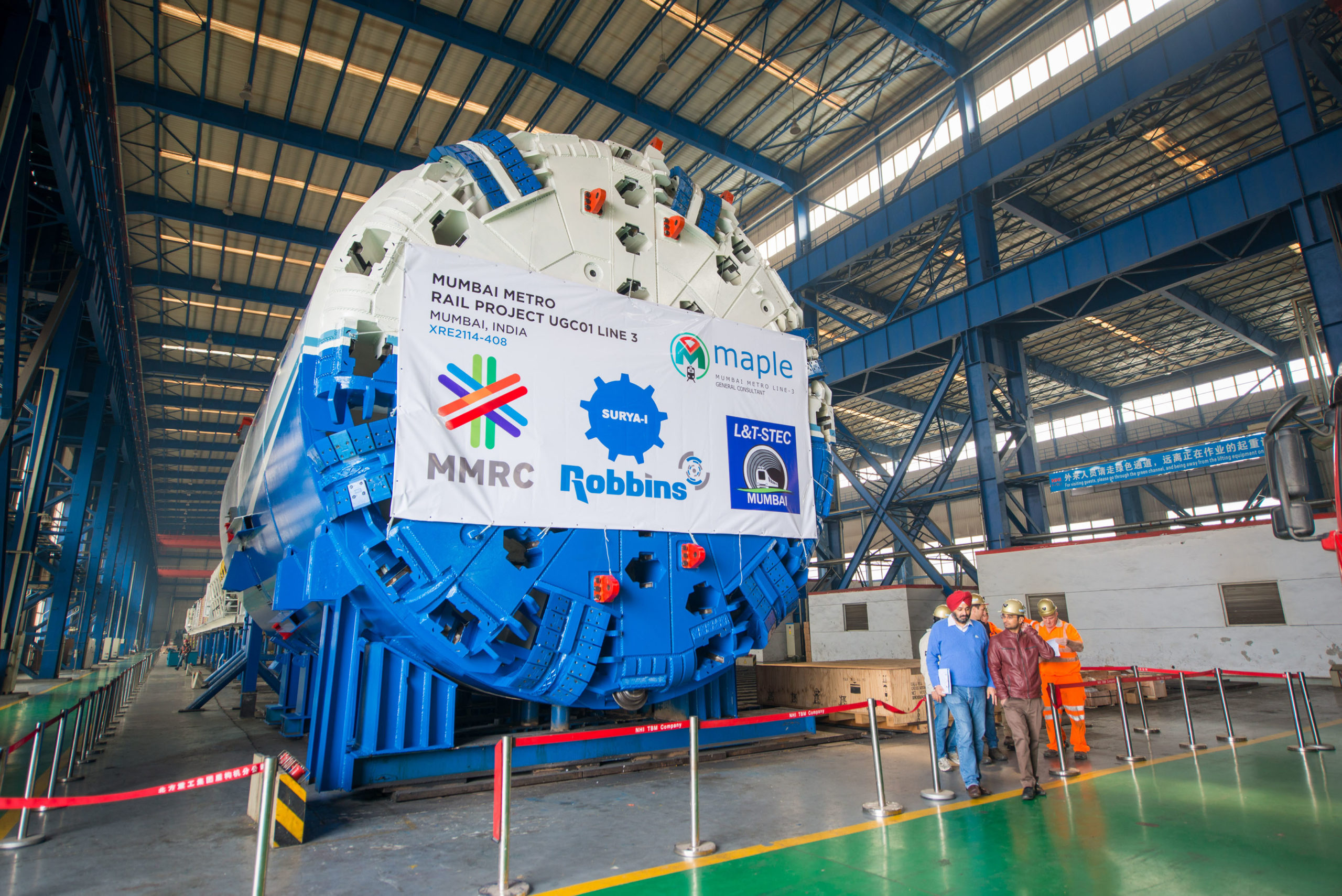
The Robbins Crossover TBMs were the first machines of their kind employed in India, using both a horizontal screw conveyor and high torque / high speed (two-speed) cutterhead drives.
L&T engineers were highly involved in the specifications and designs of the machines and worked closely with Robbins to prepare for the challenges the project presented. While L&T had extensive tunneling experience, tunneling with a Crossover machine was entirely new to them. To remedy this, Robbins provided a team of key personnel to train L&T in all aspects of the machines’ design and operation. “Working with Robbins field service was more than satisfactory. Even during the Covid-19 pandemic times, Robbins field service was available 24 hours a day, 7 days a week. What else can one expect?” said Singh.
Each milestone reached on this project is another step closer toward significantly improving the lives of Mumbai residents. As the financial capital of India and one of the most populated cities in the world, Mumbai is faced with an excessive amount of road traffic. It currently takes up to two hours to drive the 25 km (15 mi) distance from Cuffe Parade to the airport—the same trip on the finished metro will take a mere 50 minutes. The completion of Mumbai Metro Line 3, which is expected in 2025, will not only save residents transit time, but is expected to initially decrease road traffic in the area by 35%, reducing daily fuel consumption by 460,000 liters.
Cutting Edge 2021
Event Name: Cutting Edge Conference
Dates: November 15-17, 2021
Location: Dallas, Texas, USA
Come visit Robbins at the Cutting Edge Conference, and learn more about the largest hard rock TBM ever to operate in the USA at the Mill Creek Project. The 11.6 m (38.1 ft) diameter Robbins Main Beam TBM is excavating an 8 km (5 mi) long tunnel in Dallas, and is the conference’s main field trip. The annual Cutting Edge Conference examines the latest advances in tunneling technology, its methodology and how they can be harnessed to assist the nation’s major upcoming underground projects. Visit Robbins at our booth and talk to our experts with decades of experience on our latest projects and products.
Robbins XRE TBM bores Eşme-Salihli Railway Tunnel
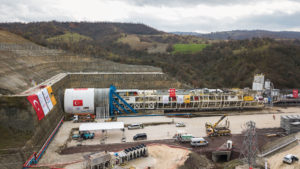
A Robbins Crossover machine is boring Turkey’s 3.05 km (1.90 mi) Eşme-Salihli Railway Tunnel through mixed conditions including sandstone, gravelstone, claystone, and siltstone for contractor Kolin Construction.
A Robbins 13.77 m (45.18 ft) diameter Crossover XRE TBM launched recently in spring 2021 in Eşme, Turkey. The large machine is boring the 3.05 km (1.90 mi) Eşme-Salihli Railway Tunnel through mixed conditions including sandstone, gravelstone, claystone, and siltstone. Contractor Kolin Construction expects some occasional groundwater and weak rock between 5 to 9 MPa (720 to 1,300 psi) UCS, with the potential for a gassy environment.
The titanic TBM was launched after more than seven years in storage, and following a few upgrades to systems to ensure they meet the newest safety and efficiency standards. “I am very happy that the TBM has been launched. Up to now, the machine has bored nearly 500 m (1,600 ft) in gneiss and mudstone. This is an opportunity for Robbins to prove that large diameter TBMs can bore in such tunnels, even in very complex geology and difficult ground conditions,” said Yunus Alpagut of ATES, Robbins’ Turkish subsidiary. Alpagut went on to explain why the project is so important: “Recently, there have been large diameter, non-Robbins machines that have failed at projects such as the high-speed railway in Bilecik, so this is very important to show the Turkish tunneling industry that large machines are up to the challenge.”
To get through the challenging conditions, the large diameter XRE has a number of unique features. The large diameter design enables both a screw conveyor and belt conveyor to remain in place, enabling swift conversion between modes, and operation in 100% EPB and hard rock modes.
In EPB mode, the screw conveyor operates as in any typical EPB machine. The screw features a replaceable inner liner and replaceable carbide wear bits for abrasion protection. A mixed ground cutterhead is fitted with knife bits that can be switched out with disc cutters in harder conditions. The machine design includes a man lock for cutterhead inspection and changes, and mixing bars inside the mixing chamber.
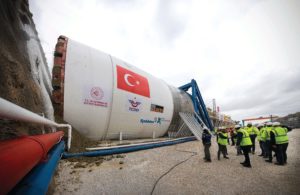
The large diameter Robbins Crossover TBM has bored nearly 500 m (1,600 ft) in gneiss and mudstone as of May 2021.
To convert to hard rock mode, the mixing bars and initial portion of the screw conveyor can be optionally retracted. EPB knife bits are then replaced with disc cutters on the cutterhead, and the EPB scrapers on the cutterhead are replaced with bucket lips. Muck paddles are installed in the cutterhead to allow the muck to fall into the muck chute. A hydraulic muck ring allows a chute attached to the bulkhead to move forward and down at a diagonal angle, allowing rock chips to be deposited in the chute and through the screw conveyor onto the TBM belt conveyor. To keep up production rates in both modes, the Robbins Torque-Shift System is used: a two-speed gearbox that enables efficient tunneling in hard, mixed, or soft ground.
The Eşme-Salihli Railway Tunnel is part of the Ankara-İzmir High Speed Railway Project for the Turkish State Railways (TCDD). The 508 km (316 mi) line will eventually connect Polatlı in Ankara Province to Izmir, the third most populous city in Turkey, surpassing the Istanbul-Ankara High-Speed Railway as the longest rail line in the country once complete. The double-track railway system will convey passengers at top speeds of 250 km/h (160 mph), completing the journey between the two cities in 3.5 hours—a journey that would normally take 6.5 hours by car.
BTS 2021
Event Name: BTS Conference and Exhibition
Dates: September 30-October 1
Location: London, UK
Venue: QEII Conference Centre
Stand: B26
Register for the British Tunnelling Society’s upcoming conference and learn about the industry’s latest trends with 800+ other tunneling professionals. Debate and analyze the latest trends and topics in underground construction, and be sure to check out the lecture by Robbins President Lok Home. Stop by our stand B26 to talk about the latest Robbins products and projects with our team of international experts.
Robbins Lecture Description
Thursday September 30
Session 3 – Innovation in Action
2:00 – 2:20 PM
Non-Circular Tunnelling: A New Way Forward – Lok Home, Robbins President
When a flat roadbed is needed, is a circular TBM the best way to go? In this exclusive presentation, Robbins President Lok Home will discuss methods and equipment currently being used in the mining industry for flat inverts, and its increasing potential for use in civil tunneling. Home will look at case studies in both mining and civil tunneling industries to demonstrate that by using non-circular TBMs, a flat invert can be safely and economically created in one pass.

 Close
Close  Menu
Menu 